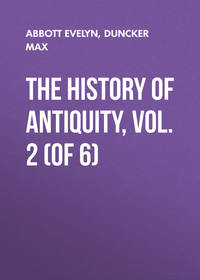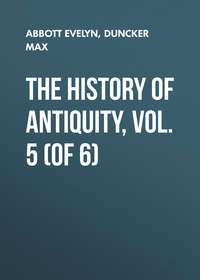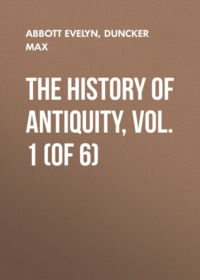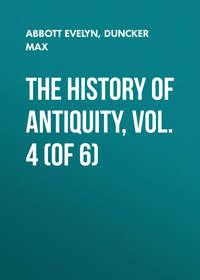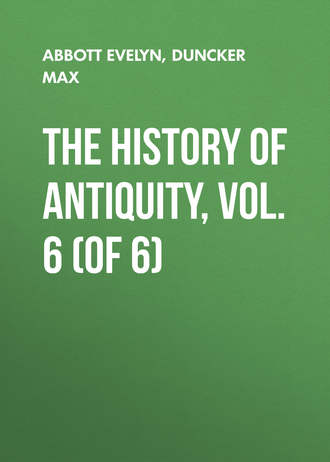 полная версия
полная версияThe History of Antiquity, Vol. 6 (of 6)
Darius perceived that the kingdom could not be governed or maintained without good communications. When the western border of the empire touched the Hellespont, the palaces in Persia were too far to the east; and the difficulty was increased when Africa, as far as the greater Syrtis, and the Thracian coast and Macedonia in Europe had been conquered. Reasons of this kind must have induced Darius to place the centre of administration as nearly as possible in the centre of the kingdom; yet he dared not venture to move too far from Persia. He did not hesitate to move his residence further to the west out of the native territory into Susiana, a region occupied by subjects of alien race and language, and make Susa the centre and metropolis of the kingdom. Strabo tells us that Cyrus and the Persians saw that, after the subjugation of the Medes, their land lay at the remote edge, while Susiana was more in the centre, and nearer the Babylonians and the other nations. For this reason they transferred the seat of the monarchy there, availing themselves of the proximity of the land and the fame of the city. The change was the more desirable because Susiana had never pursued an ambitious course of policy, but had always been part of a larger state, except perhaps in the times of the heroes.348 It is a mistake in Strabo, which however Herodotus and Aeschylus had already made, to say that Cyrus transferred the residence from Persia to Susa. Aeschylus speaks of Darius as the Susa-born god of Persia; and Herodotus places the palace and government of the Pseudo-Smerdis at Susa; it is from the tower of the walls of the citadel of Susa that Prexaspes throws himself; there the Magian is assassinated, Darius is raised to the throne, and resides from the very beginning of his reign. But this is an anticipation of the residence which was erected here by Darius with the intention that it should be the fixed abode of himself and his successors, the centre of the kingdom and the government. Pliny and Aelian tell us definitely that Darius built Susa the royal citadel of the Persians, and the inscriptions confirm this statement.349 Not less incorrect is the remark of Strabo, that Susiana had always formed part of a larger kingdom, and had never pursued an ambitious policy. On the contrary we saw how Elam, after an independence of 1500 years, became subject first to Assyria for a few decades, and then to Media and Persia. And the Elamites had so little forgotten their ancient days that they rose three times against Darius.350
The intention to keep the Semitic lands in check, to be nearer Babylon, without giving up the communication with the native land, must have contributed to the resolution of Darius to transfer the residence to Susa. If Nebuchadnezzar of Babylon had carried a road from his metropolis in a slanting direction through the desert to Syria (III. 365), works of this kind were far more urgently needed for the immensely greater extent of the Persian empire. Great roads must be made from Susa in all directions to the borders of the empire, and maintained. Though Cyrus and Cambyses may have made some steps in this direction, it was Darius who carried out the plan and founded the great system of roads which traversed Persia in all directions, and were now carried from Susa. "Who," asks Xenophon, "could so quickly strike down opponents, separated from him by a road of many months, as the king of the Persians?"351 At the close of his "Persian History" Ctesias gave a sketch of the Persian roads, which led from Ephesus to Bactria and India, with an account of the stations, days'-journey, and parasangs. This is lost. We know but one member of the system, the road which led from Susa, past Sardis, to Ephesus. Of this road, which interested the Greeks most, Herodotus gives the following account: "From the Greek sea to Susa is a distance of 14,040 stades (1755 miles). From Ephesus to Sardis is a distance of 540 stades (67½ miles), which can be traversed in three days. From this point there are royal stations and the most excellent inns: the whole road passes through inhabited lands and is secure. First, it passes through the region of the Lydians, who inhabit a fruitful land and are rich in silver; then through the region of the Phrygians, who are rich in cattle and fruits of the field; these make up 20 stations, 94½ parasangs. Then the Halys has to be crossed; there are gates here through which you must pass in order to go over the river, and a strong guard-house. Beyond the river you are in Cappadocia, and to the borders of Cilicia is a distance of 28 stations and 104 parasangs. On the borders of Cappadocia and Cilicia are two gates and two guard-houses: passing through Cilicia in three stations, a distance of 15 parasangs, you reach the border of Armenia which is formed by the Euphrates. The Euphrates is crossed by a ferry. In Armenia, which possesses much cattle, there are 15 stations provided with guard-houses, and 56½ parasangs. Then follows the Tigris, and two other rivers bearing the same name (the Greater and the Lesser Zab); and finally the Gyndes, which Cyrus diverted from its channel: these have to be crossed in boats. From Armenia you pass to the Matieni, the neighbours of the Armenians; here there are 34 stations and 137 parasangs to be traversed; from the borders of the Matieni and the Cissians (i. e. the Susiani) to the Choaspes, where Susa is built upon it (this river has also to be crossed by a ferry), are 11 stations and 42½ parasangs, making a total of 111 stations and 450 parasangs, or 13,500 stades (1687½ miles). Hence if the royal road has been rightly measured, and a traveller makes 150 stades (five parasangs, 19 miles) a day, he goes from Sardis to Susa in 90 days, and to Ephesus (if we add in the distance from Ephesus to Sardis) in 93 days."
From this description we see that the road has been accurately measured, well-kept, guarded, and provided with stations about every 15 miles, in which the travellers could find shelter. As Herodotus calls these inns very beautiful, we must assume that after the Persian fashion they were provided with plantations, and this is confirmed by other evidence. We are told that a station on the royal road in Cadusia, in a wholly bare and treeless region, was surrounded by a park of high pines and cypresses. The Indians also were accustomed to plant their roads and provide them with shady resting-places. The road from Sardis to Susa did not take the shortest route; the object was to escape the Syrian and Phrygian desert, and carry the road through regions which could support the army on the march. Hence it ran from Susa in the valley of the Tigris on the left bank of the river through Susiana and the native land of the Assyrians, for 600 miles in a north-westerly direction, to the mountains of Armenia. The region between the Tigris and the Zagrus to the north of the satrapy of Cissia (Susiana) is called by Herodotus the land of the Matieni, and he extends this name, which is elsewhere used only for the tribes dwelling round the Lake of Urumiah, to the Tigris. Armenia proper was then crossed by the road in a straight line from east to west, from the upper Tigris to the upper Euphrates. Of Cilicia it touched merely the north-east corner, and then cut through Cappadocia in a north-westerly direction to the Halys. It crossed the river in the neighbourhood of Pteria, passed in a south-westerly direction through Phrygia, leaving the desert to the south, and Lydia to Sardis.352 From this great road to the west then branched off between the Gyndes (Diala) and the Physcus (Adhem) the road to Babylon, and at Physcus the road to Ecbatana.
The royal roads through the kingdom secured before all things the rapid operation of the central power and the king on the representatives of his power in the provinces. The stations were used for a postal arrangement, the duty of which it was to carry the commands of the king and the reports and questions of the satraps. Thanks to this post the king was in the possession of a means of communication far superior to that within the reach of any of his subjects. At the stations on all the roads of the kingdom, at intervals of 15 miles or a little more, horses and riders (Astandae, Angari) were placed, whose sole business it was to carry the royal messages and errands. One of these postmen must always be in attendance, in order to carry a letter as soon as it arrived, at the full speed of his horse, by day or by night, in heat or in snow, to the next station. Among the Greeks it was said that the Persian couriers travelled swifter than cranes; Herodotus also assures us that nothing in the world was more rapid than these horsemen.353 Thus the king's commands travelled on well-built and carefully-guarded roads by this post in the shortest space of time to the most remote provinces. They were brought from Susa to Sardis in five or six days and nights. The commands of the king to the satraps were always given in writing, and accredited by the impression of the king's seal.354 This seal presents to us king Darius with the covered tiara on his head standing on the chariot behind the charioteer; a lion, struck by his arrow, lies beneath the hoofs of the horses which are leaping forward. The king is about to shoot a third arrow at a second huge lion, which has reared himself up in self-defence, and has already received two arrows from the king. At the side a date palm is visible; over the king hovers Auramazda. The inscription, which is in three languages, says: "I am Darius, the great king."355 The rapidity with which the king's commands reached even the satraps of the most distant lands, kept the authority of the king before them. The fortresses and guard-posts on the roads not only served to maintain security on and near them, and to make commerce safe; they were also used to control trade, and travelling, and any correspondence among the subjects. The fortresses were placed at points which could not be avoided, in narrow passes, or on the bridges of great rivers. Those in command dared not allow any one to pass who did not establish his right, as above suspicion. The scribes assigned to the commanders looked over all the letters, which were carried through by messengers.356 As the fortresses in which these guard-posts lay were placed in the most important divisions of the country, the roads could be closed by the posts. If a rebellion arose in this or that quarter, the effect on the neighbouring province was checked by closing the roads by means of the forts, or the road was defended from post to post. And if an enemy invaded from outside he found in them points of resistance, and the Persians points of support.
The guidance and control of the viceroys was not confined to the rapid and lively communications between them and the king. The Greeks tell us that the king travelled every year to this or that province in order to review the troops, and examine the cultivation of the soil. Where the king did not make a visitation in person, he did so by confidential ministers. We are further informed that these visitations were entrusted to the princes of the royal house.357 Where the king found that the land was populous and well cultivated, the forests in good order, and the fields full of the fruits which the land produced, he distinguished the governor by gifts and honours. But where he found the land thinly populated and badly cultivated, whether it was owing to the severity, the neglect, or the extortion of the satrap, the satrap was punished and removed from his place.358 The charge of the whole country lay on the chief overseer, the high official who bore the title of the "king's eye." In the Persians of Aeschylus, the chorus inquire of Xerxes, "Where his faithful eye has remained?" Herodotus notices as an arrangement of the Median kingdom, that the king named a man especially devoted to him, his "Eye." We see that unexpected inspections were made by the "Eye" of the Persian king, and that his subordinates, who were not known to be such, carried on a minute superintendence over the conduct of the satraps, the other officers, and the subject people.359 Still more mysterious was the work of the officers who were known as the king's "Ears." They cannot have been far removed from spies. We saw to what an extent the princes of India carried on the system of secret espionage. Herodotus told us in regard to Deioces that his spies and informers were in every land, and a Persian proverb said, "The king has many eyes and ears." The Greeks declare that the Persian spies did not always content themselves with relating what they had heard, but told much besides in order to show their zeal. Accusation was received with favour by the king and rewarded by distinctions and presents.360 We saw what control was exercised on the great roads, the arteries of communication. Owing to the number of guard-houses in each road, which repeated the inquiries of the first, any one at the court was in a position to compare the accounts of the commanders, and to control them. No one passed even the borders of Babylonia without proving who he was, and of what city, and why he was travelling.361 In this way every suspicious circumstance was brought to light, and it was certain that no conspiracy or rebellion could be contrived without some indications being received at the court of the king.
What could not be prevented by the control of the higher and lower officers, and the police supervision of the subjects, was suppressed by the severe exercise of punishment, which was intended to strike fear into magistrate and subject alike by the force of terrible examples. The terrorist use of punishment which the Brahmans on the Ganges knew how to prove to be a divine right, and a duty of the royal office, was in Persia regarded as an indispensable means for supporting the state. And as a fact obedience to the absolute ruler rested, in the magistrates and the ruling tribe, more decidedly on the apprehension of punishment than on any personal interest or common share in the maintenance of the kingdom; and in the subject nations it rested on the fear of the ruler and the interests which the Persian kings gained in those districts. Those entrusted with the power of office must also be the most obedient and submiss. Above all, the feeling must be kept alive in the satraps of the provinces that the enormous powers delegated to them were given on the condition of absolute obedience. The severe penalties which overtook any resistance, or the careless execution of a royal command, were only the reverse of the favours which fell to their lot in other circumstances. However earnestly the religion of Zarathrustra preached the regard for life, the rules of religion were compelled, even in Persia, to give way to reasons of state. We find Darius no less than Cambyses inflicting severe penalties for trifling offences. If the satraps gave any grounds for suspicion, they were either secretly or openly removed out of the way.362 But even in the judges and on those who were not officers every transgression and act of disobedience to the wish of the king was cruelly punished. Darius, who was not considered a harsh ruler, did not content himself with the execution of Intaphernes; he caused nearly all the males of the house to be put to death, though Intaphernes had taken such a prominent part in the assassination of the Magian. The leaders of the rebellions in the provinces were punished by crucifixion or hanging. Khsathrita, who caused the Medes to revolt, and Chitratakhma, the leader of the Sagartians, had their noses and ears cut off before execution, and in this state were exposed to public view.363 When Darius marched against the Scythians, Oeobazus, a distinguished Persian, entreated that one of his three sons might remain behind. The king considered that this wish was not in harmony with the devotion which every Persian owed to the kingdom; he replied that all his sons should remain, and at once ordered them to be executed. Sandoces, one of the royal judges, had been bribed to give a false judgment; Darius caused him to be crucified; he was already placed on the cross when the king remembered that he had done more good than evil to the royal house, and ordered him to be taken down again. He lived, and remained in the service, but not in the highest court of the kingdom.364 One of the mildest forms of punishment was banishment to the islands of the Persian Gulf. Common punishments were the loss of eyes, nose, ears, tongue; the cutting off of hands, arms, and feet; scourgings were frequent, and they were inflicted even by the satraps.365 The king pronounced the sentence of death by touching the girdle of the accused, or occasionally allowed it to be pronounced in his presence by the seven judges. The sentence was then carried out by crucifixion or decapitation.366 In later times we hear of grinding between stones, incisions in the body while alive, and painful imprisonment in troughs; Xenophon indeed tells us that one of those who took part in the rebellion of the younger Cyrus was tortured for a whole year.367
If we compare the practice of the princes of Persia with the conduct of the Assyrian kings, and the later rulers of the East, we cannot fail to recognize that the officers under the Achaemenids were in a better position and more richly paid, but also better controlled and kept in greater dependence than was the case afterwards. The subjects, in spite of acts of cruel caprice which affected certain persons, were incomparably better off than those of the Assyrians, or of the dynasties which afterwards ruled the East. They were governed with more intelligence and clemency than the subjects of the Porte, or the Khedive, or the Shah of Persia, or the Emirs of Cabul and Herat. It was no small thing that the Persian kings established peace in all Asia from the shores of the Hellespont to the Belurdagh, and maintained order and security from the Nile to the Himalayas. Moreover, the religion and worship of the subject nations, of whatever kind they might be, were not injured, but rather protected and held in honour. Law, justice, and manners remained the same, and the subjects preserved their local self-government. Agriculture in the provinces received attention, trade and commerce went on along the roads and rivers of the vast empire, and was not only unmolested but protected.
CHAPTER XVIII.
THE FINANCE AND ARMY OF DARIUS
The empire of Darius rested on the fact that the Persians regarded themselves as the governing nation in Asia, and on their desire and determination to maintain this position, with the advantages which it brought to them; on the devotion and fidelity with which the Persian tribal princes and nobles stood by the king; on their habits of obedience and subjection; on the ambition of officers and governors, which was excited by obvious distinctions; on the education of a considerable portion of the Persian youth specially for service in the army and the state. Darius was at pains to add to these foundations substantial means for maintaining the empire in the greatest profusion. When he abandoned the system of Cyrus and Cambyses, who had allowed the provinces to fix the amount of their yearly tribute themselves, and set himself to secure a fixed income for the state, it was previously necessary to fix the standard according to which the tribute, which would now be paid as taxes, should be assessed; to arrange the value at which the royal chest would accept the various standards current in the subject nations.
With this object he created a currency. He founded his standard on the forms which the Babylonian system had developed in the course of time. The new gold currency was struck on the standard of the Babylonian gold talent, i. e. on a normal weight of 50½ pounds. Three thousand coins were struck out of this total. The gold in this new currency was purer than that used by Crœsus, or in the older coins in the Ionic cities of Asia Minor; the coins which have come down to us show but little alloy of silver. The gold piece weighed 8.40 grammes; and had in our coinage a value of about 21 shillings; hence the gold talent of Darius was worth 3000 guineas. These new pieces were called by the Hebrews Darkon and Darkemon, among the Greeks Darics. It was of the first importance to bring the gold of the coinage into a simple and easily convertible ratio with silver. In order to do this the silver coins were struck from a larger weight than the gold. Here also Darius used a Babylonian talent; – the silver talent of 67½ pounds, for the normal weight. From this 3000 staters were struck of a weight of 11.14 grammes; or 6000 drachmas of a weight of 5.57 grammes. The silver staters of Darius (silver darics) were called by the Greeks Median sigli (shekels). As gold was valued at 13⅓ times the value of silver, the silver stater, which was one-fourth heavier than the gold coin, was equal to a tenth part of its value, and the drachma to a twentieth. Hence the gold daric was changed for ten silver staters or twenty silver drachmas. The silver talent of Darius was worth more than £300 of our money, the silver stater was worth about two shillings. The silver talent of Darius (which the Greeks call the Babylonian talent) stood to the Euboean talent of the Greeks, who had used the light Babylonian talent as a standard, in a ratio of 3 to 4.368
The new darics were marked with the figure of the king. Three hundred have been lately found in the bed of the canal which the son of Darius caused to be cut through the promontory of Athos; and they exhibit Darius running or kneeling, in a long cloak, with the kaftan over it, the royal tiara on the head, with thick hair and beard; in the right hand, which is depressed, we find a lance; sometimes a sword; and in the left, which is outstretched, the bow. The silver coins of the king also carried his image; in these he sometimes holds an arrow instead of a bow in his left hand. For the Syrian districts Darius had a special large silver coin of about 28 grammes struck, in addition to the royal currency. These present the king with his right hand elevated and his left depressed, on his chariot, which is drawn by four or six horses, which spring over a dead lion. On the reverse is the picture of a city with towers. On other coins of the same kind, the reverse of which presents a galley with rowers, the king is also on his chariot, the horses are moving slowly, and the royal staff-bearer follows the chariot.
The new coinage was not entirely to expel or replace the standards current in the provinces. The coining of gold was indeed reserved for the crown, but the old silver coins of the provinces were not only allowed to be current, they might even be increased, for the right to coin silver was left to the districts, cities, and dynasties. They were allowed to use their own standards, and mark their coins in whatever way they pleased. Communities could put the arms of the city, the dynasts their own portraits, on the coins. The satraps also had the right to coin silver coins, and mark them with special emblems, their names or portraits (among the emblems we find two men before a fire-altar, the form of Auramazda, etc.). The silver money which the satraps struck had no legal privileges over the common coins of the provinces. In the first instance they were coined in exceptional cases when there was a deficiency of the currency, or money was needed for important military undertakings. The satraps, like the countries, the cities, and dynasts, rarely coined after the royal standard; they generally followed the standards common in their provinces in order to meet the local needs.369 In the fourth century B.C. they began to coin more frequently. At the chest of the king only the royal currency was accepted; all other coins were received as bullion, weighed by the royal standard, and then melted down in order to be struck in the royal currency and issued when required.370
It was the opinion of Darius that the crown ought to possess the means for the largest outlay that could be demanded. The treasury of Cyrus was not perhaps exhausted, but no doubt it was seriously diminished by the campaigns of Cambyses, the Magian, the rising of Vahyazdata, and the suppression of the rebellions. The object to be attained was that the yearly income should considerably surpass the yearly expenditure; the excess could then be collected in the treasury, which would thus be in a position to pay and support for years the largest armies that could be required. The care which Darius bestowed on the currency and taxation astonished the Persians, who no doubt remembered the magnanimous conduct of Cyrus, to whom such things were of little moment; as Herodotus tells us, they called him the "retail-dealer" in contrast to Cyrus.371 The measure, by which Darius imposed on all his lands the taxes which they had to pay year by year, was the produce of their soil. If the tax which was thus laid on the soil of the provinces on a fixed ratio was not excessive, they were nevertheless subject to services, and the crown could with certainty reckon on the payment of the contributions. The whole amount of arable land in the provinces was measured by parasangs (each of 30 stades); and according to the extent, when thus ascertained, and the quality of the soil, as Herodotus states, the taxes of the provinces were fixed in the royal currency. Within each province the various countries and cantons, which formed a political unit, whether under dynasts or chieftains, or some other form of constitution, were burdened with a fixed share of the contribution of the whole – as we may see from the statement that the overseers of the cantons and countries were responsible for the payment of the taxes. After exhausting wars, new measurements were made with a view to further valuations.372 The lowest contribution of land-tax was made by the satrapy of the Arachoti (the Pactyans of Herodotus), and the Gedrosians (the Sattagydae of Herodotus), to which belonged also the Gandarians to the south of Cabul; it amounted to 170 talents of silver (about £50,000); the next lowest amount was 200 talents, (about £57,000), which was paid by two satrapies, the Saspeires and Alarodians in the valley of the Araxes, and the Caspians, i. e. the Cadusians, the Mardians, the Tapurians, and Hyrcanians. The satrapy of the Sacians paid 250 talents (£70,000). Four satrapies paid 300 talents (£85,000), the satrapy of the Parthians, Areians, Chorasmians and Sogdiani, of the Moschians and Tibarenes, of the Ionians and of the Susiani. The satrapy of Syria with Phœnicia and Cyprus paid 350 talents (£100,000); the satrapies of Bactria and Phrygia with Cappadocia paid 360 talents each (£103,000); Armenia, and the satrapy of the Paricanians and Ethiopians in Asia, paid 400 talents each (£115,000); Media had to pay 450 talents (£130,000); the satrapies of Lydia and Cilicia 500 each (£145,000); Drangiana (the Sarangians and Sagartians) paid 600 talents (£170,000); Egypt with Cyrene, Barca, and the tribes of the Libyans, 700 talents (£200,000); the satrapy of Babylon, i. e. the region to the south of the Armenian mountains between the Euphrates and the Tigris as far as the mouth of the rivers, paid 1000 talents (i. e. £290,000). This was the highest tax imposed on any satrapy; from this assessment, as well as from other evidence, we may conclude that Babylonia was the best cultivated and most fruitful province in the whole kingdom. The entire income from this satrapy is put by Herodotus at an artabè of silver daily, and the Persian artabè was larger by three choenixes than the Attic medimnus. The artabè, therefore, was about equal to a Prussian bushel, i. e. to a measure of 2770 cubic inches.373


